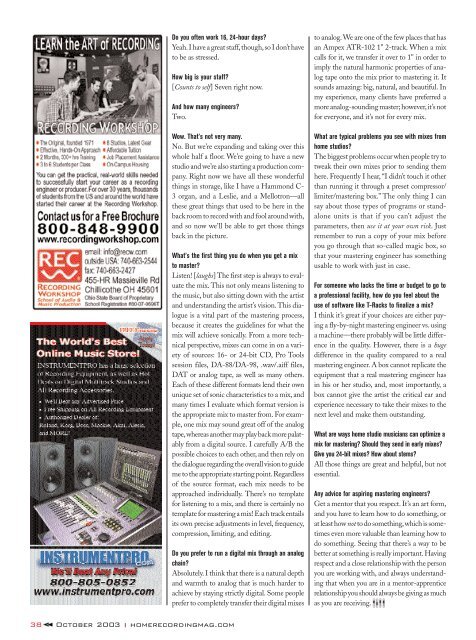Create successful ePaper yourself
Turn your PDF publications into a flip-book with our unique Google optimized e-Paper software.
Do you often work 16, 24-hour days?Yeah.I have a great staff,though,so I don’t haveto be as stressed.How big is your staff?[Counts to self] Seven right now.And how many engineers?Two.Wow. That’s not very many.No. But we’re expanding and taking over thiswhole half a floor. We’re going to have a newstudio and we’re also starting a production company.Right now we have all these wonderfulthings in storage, like I have a Hammond C-3 organ, and a Leslie, and a Mellotron—allthese great things that used to be here in theback room to record with and fool around with,and so now we’ll be able to get those thingsback in the picture.What’s the first thing you do when you get a mixto master?Listen! [laughs] <strong>The</strong> first step is always to evaluatethe mix. This not only means listening tothe music, but also sitting down with the artistand understanding the artist’s vision. This dialogueis a vital part of the mastering process,because it creates the guidelines for what themix will achieve sonically. From a more technicalperspective, mixes can come in on a varietyof sources: 16- or 24-bit CD, Pro Toolssession files, DA-88/DA-98, .wav/.aiff files,DAT or analog tape, as well as many others.Each of these different formats lend their ownunique set of sonic characteristics to a mix, andmany times I evaluate which format version isthe appropriate mix to master from. For example,one mix may sound great off of the analogtape,whereas another may play back more palatablyfrom a digital source. I carefully A/B thepossible choices to each other, and then rely onthe dialogue regarding the overall vision to guideme to the appropriate starting point.Regardlessof the source format, each mix needs to beapproached individually. <strong>The</strong>re’s no templatefor listening to a mix, and there is certainly notemplate for mastering a mix! Each track entailsits own precise adjustments in level, frequency,compression, limiting, and editing.Do you prefer to run a digital mix through an analogchain?Absolutely. I think that there is a natural depthand warmth to analog that is much harder toachieve by staying strictly digital. Some peopleprefer to completely transfer their digital mixesto analog. We are one of the few places that hasan Ampex ATR-102 1" 2-track. When a mixcalls for it, we transfer it over to 1" in order toimply the natural harmonic properties of analogtape onto the mix prior to mastering it. Itsounds amazing: big, natural, and beautiful. Inmy experience, many clients have preferred amore analog-sounding master;however,it’s notfor everyone, and it’s not for every mix.What are typical problems you see with mixes fromhome studios?<strong>The</strong> biggest problems occur when people try totweak their own mixes prior to sending themhere. Frequently I hear, “I didn’t touch it otherthan running it through a preset compressor/limiter/mastering box.” <strong>The</strong> only thing I cansay about those types of programs or standaloneunits is that if you can’t adjust theparameters, then use it at your own risk. Justremember to run a copy of your mix beforeyou go through that so-called magic box, sothat your mastering engineer has somethingusable to work with just in case.For someone who lacks the time or budget to go toa professional facility, how do you feel about theuse of software like T-Racks to finalize a mix?I think it’s great if your choices are either payinga fly-by-night mastering engineer vs. usinga machine—there probably will be little differencein the quality. However, there is a hugedifference in the quality compared to a realmastering engineer. A box cannot replicate theequipment that a real mastering engineer hasin his or her studio, and, most importantly, abox cannot give the artist the critical ear andexperience necessary to take their mixes to thenext level and make them outstanding.What are ways home studio musicians can optimize amix for mastering? Should they send in early mixes?Give you 24-bit mixes? How about stems?All those things are great and helpful, but notessential.Any advice for aspiring mastering engineers?Get a mentor that you respect. It’s an art form,and you have to learn how to do something, orat least how not to do something,which is sometimeseven more valuable than learning how todo something. Seeing that there’s a way to bebetter at something is really important. Havingrespect and a close relationship with the personyou are working with, and always understandingthat when you are in a mentor-apprenticerelationship you should always be giving as muchas you are receiving.38 October 2003 I homerecordingmag.com



